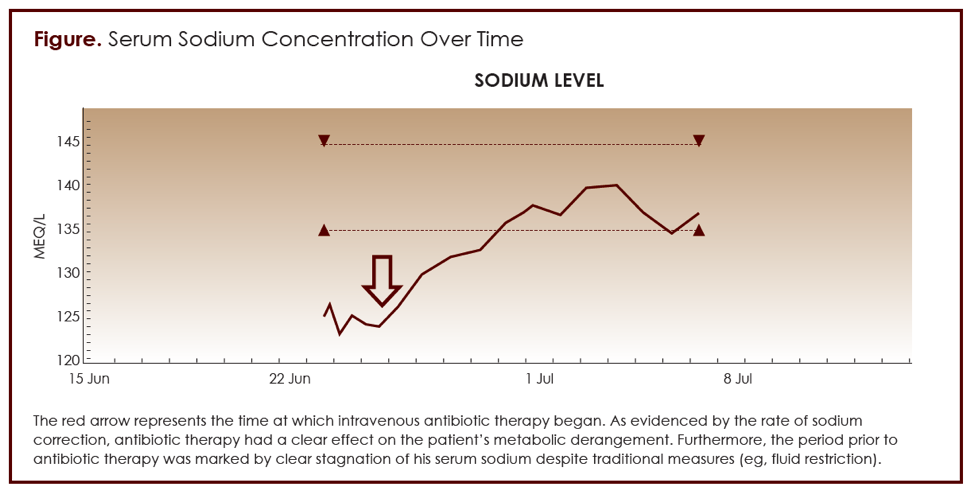Salt, Ticks, and Lyme: A Case of Lyme Neuroborreliosis Presenting as SIADH
This case report is the fourth documented case of Lyme-induced syndrome of inappro­priate secretion of antidiuretic hormone (SIADH).
HISTORY OF PRESENT ILLNESS
A 79-year-old man with a medical history of coronary artery disease and hypertension presented to the emergency department (ED) with acute onset of ataxia and double vision in June 2018. Two days prior to his admission, he was seen at an outside ED for complaints of a headache. At the outside facility, he was found to have a blood pressure of 210/105 mm Hg, which was reduced with oral antihypertensives. Imaging at that hospital did not demonstrate any acute hemorrhage, and he was discharged with instructions to follow up with his primary care provider.
On the morning of the current admission, he awoke feeling ataxic and weak and had diplopia. He attempted to ambulate and subsequently fell while getting out of bed. He denied syncope or any post­ictal symptoms during this episode. The history was obtained from his daughter, who was at his bedside. The patient was unable to give a history secondary to his condition.
MEDICAL HISTORY
Coronary artery disease, with a known drug-eluting stent placed in 2009; hypertension; hyperlipidemia; and gout.
MEDICATIONS
Norvasc 10 mg by mouth daily; losartan 100 mg by mouth daily; metoprolol 50 XL daily; atorvastatin 40 mg by mouth every night at bedtime; allopurinol 300 mg by mouth daily; aspirin 81 mg by mouth daily.
EPIDEMIOLOGICAL HISTORY
The patient was sexually active with his wife of 50 years, a nonsmoker, and a nondrinker and denied any illicit drug use. His family denied any recent travel outside the Pennsylvania area over the 6 months prior to presentation. He and his family denied any recent illness or sick contacts. He also did not own any pets, and his family did not recall any obvious pet exposures.
PHYSICAL EXAMINATION
The patient’s vital signs were within normal limits. On physical examination, he was lethargic and unable to respond coherently and appeared very fatigued. His mucous membranes were moist, and he did not have any signs of volume overload (eg, jugular venous distention, edema). His pupils were equal, round, and reactive to light, but he could not abduct his eyes. His cardiovascular assessment did not reveal any murmurs or arrhythmias, and his thoracic examination was unremarkable. His neurological examination was remarkable for 2 out of 5 strength in his upper and lower extremities, bilaterally.
RELEVANT LABORATORY DATA
Given his concerning physical examination, laboratory work was ordered to discern the etiology of his condition. Complete blood count was unremarkable; however, serum sodium was found to be 125 mEq/L (normal: 135-145 mEq/L). A chart review revealed a serum sodium level of 138 mEq/L 2 days prior to admission.
Further laboratory evaluation of the patient’s hyponatremia demonstrated serum osmolality of 269 mOsm/kg (normal 275-295 mOsm/kg), urine osmolality of 688 mOsm/kg, urine sodium of 87 mmol/L, and uric acid of 3 mg/dL.
CLINICAL COURSE
The patient presented to the hospital with concerning physical examination and metabolic derangements. Initially, the work-up and management concerned his hyponatremia. On presentation, his hyponatremia was classified as hypotonic and euvolemic. Given his high urine osmolality and high urine sodium, his hyponatremia appeared to be related to syndrome of inappro­priate secretion of antidiuretic hormone (SIADH). The patient was placed on fluid restriction for initial management of SIADH and did not show much neurological improvement or correction of his hyponatremia. Because fluid restriction usually corrects underlying hyponatremia related to SIADH, additional etiologies were sought. Thyroid and adrenal studies were checked, as these functions are known to also mimic or confound a diagnosis of SIADH, but results were within normal limits.
Given that the etiology of the patient’s SIADH remained a mystery, radio­logical surveillance was undertaken to search for any possible lesions or malignancies. A chest x-ray was concerning for a possible lesion in the thoracic cavity, which led to further evaluation via bronchoscopy. It was thought that the patient may have had neuroendocrine sequelae of SIADH related to a possible thoracic malignancy. However, the results of the bronchoscopy proved to be fruitless and were simply demonstrative of a mucous plug, which had no clinical significance.
The patient was not improving, so a reassessment of the history of the present illness was repeated with his family members. A careful and in-depth history revealed that 2 months prior to presentation, the patient had been hiking in the woods with his grandchildren and could have been bitten by a tick. This led to subsequent testing for Lyme disease, which was confirmed via a Western blot analysis.
Once the appropriate diagnosis of Lyme disease was made, intravenous ceftriaxone therapy was initiated. There was a rapid improvement in the patient’s metabolic panel and his neurological status (Figure). On the day of discharge, the patient was more lucid, was answering questions appropri­ately, and had full strength in his upper and lower extremities. He finished a 4-week course of ceftriaxone with resolution of his ataxia and diplopia.

DIAGNOSTIC PROCEDURES AND RESULTS
Borrelia burgdorferi enzyme-linked immunosorbent assay with a reflexive Western blot demonstrating 6 confirmatory IgG bands: 18 kDa, 28 kDa, 30 kDa, 39 kDa (BmpA), 45 kDa, and 66 kDa.
DISCUSSION
Hyponatremia is the most common electrolyte imbalance seen in clinical practice.1 In patients older than 65 years, SIADH was the main culprit in over half of all cases of hyponatremia.2 The most common etiologies of SIADH are malignancy, medications, and central nervous system (CNS) disorders.3 CNS infections are a rare but known cause of SIADH and include bacterial and enteroviral meningitis, tuberculosis, herpes simplex, St. Louis encephalitis, and La Crosse encephalitis. Management of SIADH involves treating the underlying etiology; however, management becomes more difficult when the cause of the SIADH is not identified and significantly affects the patient.
This patient initially presented with vague neurological symptoms and hyponatremia, identified as SIADH. Multiple imaging modalities and invasive tests, including bronchoscopy, were performed, but a cause for the SIADH remained unknown. Eventually, a thorough discussion with the family revealed that the patient went hiking in the woods 2 months prior to presentation. Lyme disease was positive after testing but was not identified as an etiology for the SIADH. It was not until antibiotic treatment was initiated that the patient’s hyponatremia and symptoms resolved.
Lyme-induced SIADH is a rare phenomenon, and only 3 case reports were found in the literature.4-6 A review of the cases revealed almost iden­tical presenting symptoms and hospital course to the patient’s. In the case reports, the patients were eventually tested for Lyme disease, and after appropriate antibiotic treatment was initiated, complete resolution of all symptoms and hyponatremia occurred.
This case identifies 3 major problems that affected the patient: a prolonged hospital course, a significant financial burden, and a delay in care. Our patient underwent multiple imaging studies, including invasive testing, but a clear cause for the SIADH could not be determined. In addi­tion to having to wait for the diagnosis of Lyme disease, the patient was exposed to a prolonged hospital course and incurred unnecessary medical costs. A more thorough history and education about the lesser-known consequences of Lyme could have led to earlier diagnosis.
In addition, further research is needed regarding the pathophysiology and sequela effects of Lyme-induced SIADH. Given that the hypothal­amus secretes antidiuretic hormone, it is clear that CNS involvement of Lyme disease may be associated with endocrinopathies. Understanding this mechanism may broaden the understanding of not just Lyme disease but also the interplay between tick-borne illnesses and undiagnosed or perplexing endocrinopathies.
SIADH is a common disorder that can be treated only by identifying the correct etiology. When practitioners are unable to determine the root cause, patients undergo a prolonged hospital course, incur significant medical costs, and experience a delay in care. Resolution of the patient’s SIADH ultimately occurred after discovery and treatment of Lyme disease via the least expensive modality: a more thorough history. This case report is the fourth documented case of Lyme-induced SIADH. All cases had similar hospital courses, including incidental diagnosis of Lyme and complete resolution of symptoms when antibiotics were administered. This case report is another piece of evidence to support this medical phenomenon and stresses the importance to the medical community of including Lyme disease as a differential for SIADH.
Dr. Karnik is a current PGY-2 resident in the department of internal medicine at Drexel University College of Medicine/ Hahnemann University Hospital and is interested in pursuing a career in academic gastroenterology.
Dr. Rossi is a current PGY-3 resident in the department of internal medicine Drexel University College of Medicine/ Hahnemann University Hospital and is excited to pursue a career in infectious diseases.
Dr. Parikh recently graduated from Drexel University College of Medicine/Hahnemann University Hospital residency program and is currently working as a hospitalist.
Dr. Sangitha is a 2018 graduate of Drexel University College of Medicine/Hahnemann University Hospital (HUP) who is currently in an internship in internal medicine at HUP.
References:
- Soiza RL, Hoyle GE, Chua MPW. Electrolyte and salt disturbances in older people: causes, management and implications. Rev Clin Gerontol. 2008;18(2):143-158. doi: 10.1017/S0959259809002822.
- Anpalahan M. Chronic idiopathic hyponatremia in older people due to syndrome of inappropriate antidiuretic hormone secretion (SIADH) possibly related to aging. J Am Geriatr Soc. 2001;49(6):788-792.
- Baylis, PH. The syndrome of inappropriate antidiuretic hormone secretion. Int J Biochem Cell Biol. 2003;35(11):1495-1499.
- Siddiqui N, Peter DMS, Marur S. Ticks and salt: an atypical case of neuroborreliosis. J Community Hosp Intern Med Perspect. 2017;7(6):358-362. doi: 10.1080/20009666.2017.1407209.
- Syed W, Yeager J, Fariduddin M, Shah A, Dhamoon A. Tick bite causing water retention Lyme’s disease manifesting as acute hyponatremia from SIADH. Crit Care Med. 2015;43(12):315. doi: 10.1097/01.ccm.0000475085.62436.71.
- Perkins CMP, Shumway CN, Jackson MWL. Lyme neuroborreliosis presenting as the syndrome of inappropriate antidiuretic hormone secretion. MedGenMed. 2006;8(3):71.

